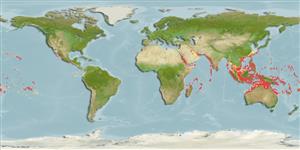>
Gobiiformes (Gobies) >
Gobiidae (Gobies) > Gobiinae
Etymology: Gobiodon: Latin, gobius = gudgeon + Greek, odous = teeth (Ref. 45335).
More on author: Rüppell.
Environment: milieu / climate zone / depth range / distribution range
Ecologia
marino; acqua dolce; salmastro associati a barriera corallina; amfidromo (Ref. 46888); distribuzione batimetrica 0 - 78 m (Ref. 86942). Tropical; 30°N - 24°S
Indo-West Pacific: Red Sea and East Africa to the Tuamoto Islands, north to the Ryukyu Islands.
Size / Peso / Age
Maturity: Lm ? range ? - ? cm
Max length : 6.4 cm TL maschio/sesso non determinato; (Ref. 116275)
Short description
Chiavi di identificazione | Morfologia | Morfometria
Spine dorsali (totale) : 7; Raggi dorsali molli (totale) : 10 - 11; Spine anali: 1; Raggi anali molli: 8 - 9. Characterized by red face with vertical blue lines; uniformly dark brown to light brown or bright green with a longitudinal thin red stripe; red stripe at the base of dorsal fins; absence of scales; complete pelvic fin frenum and basal membrane; depth of body at level of pelvic fins 2.6-3.0 in SL (Ref. 90102).
Facultative air-breathing in the genus (Ref. 126274); Marine species usually living on coral reefs but also recorded from pools, freshwater streams or lagoon mouths (Ref. 4343). Preys on copepods (Ref. 92840). Found on tabletop Acropora corals (Ref. 1602); a coral-commensal species (Ref. 72446). Monogamous (Ref. 52884). The male takes care of eggs deposited on a coral branch (Ref. 32163). Has the ability to change sex in both directions to favor reproductive success (Ref. 32163).
Life cycle and mating behavior
Maturità | Riproduzione | Deposizione | Uova | Fecundity | Larve
The male takes care of eggs deposited on a coral branch (Ref. 32163). Has the ability to change sex in both directions to favor reproductive success (Ref. 32163). Monogamous mating is observed as both obligate and social (Ref. 52884).
Hoese, D.F., 1986. Gobiidae. p. 774-807. In M.M. Smith and P.C. Heemstra (eds.) Smiths' sea fishes. Springer-Verlag, Berlin. (Ref. 2798)
IUCN Red List Status (Ref. 130435: Version 2024-1)
Threat to humans
Harmless
Human uses
Pesca: commerciale; Acquario: Commerciale
Strumenti
Special reports
Download XML
Fonti Internet
Estimates based on models
Preferred temperature (Ref.
123201): 24.8 - 29, mean 28 °C (based on 1316 cells).
Phylogenetic diversity index (Ref.
82804): PD
50 = 0.5000 [Uniqueness, from 0.5 = low to 2.0 = high].
Bayesian length-weight: a=0.01995 (0.00906 - 0.04395), b=3.01 (2.83 - 3.19), in cm total length, based on all LWR estimates for this body shape (Ref.
93245).
Trophic level (Ref.
69278): 3.5 ±0.5 se; based on size and trophs of closest relatives
Resilienza (Ref.
120179): Alto, tempo minimo di raddoppiamento della popolazione meno di 15 mesi (Preliminary K or Fecundity.).
Fishing Vulnerability (Ref.
59153): Low vulnerability (10 of 100).
Nutrients (Ref.
124155): Calcium = 183 [75, 391] mg/100g; Iron = 1.01 [0.49, 2.17] mg/100g; Protein = 18.1 [16.1, 20.0] %; Omega3 = 0.153 [0.054, 0.335] g/100g; Selenium = 30.4 [12.2, 70.7] μg/100g; VitaminA = 81.6 [18.2, 361.1] μg/100g; Zinc = 2.55 [1.57, 3.97] mg/100g (wet weight);
